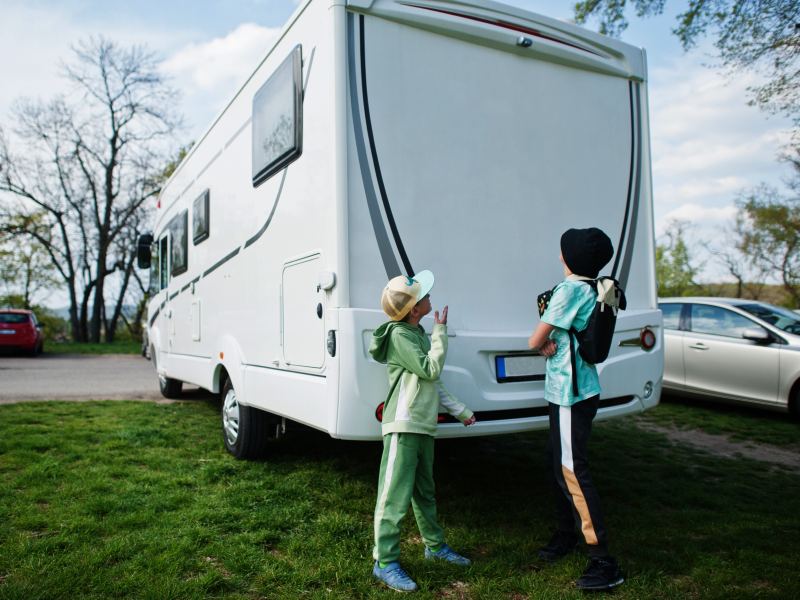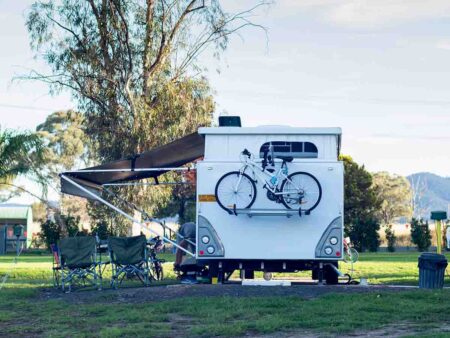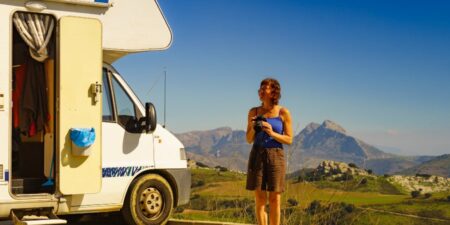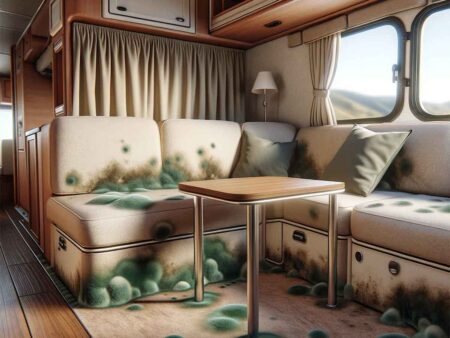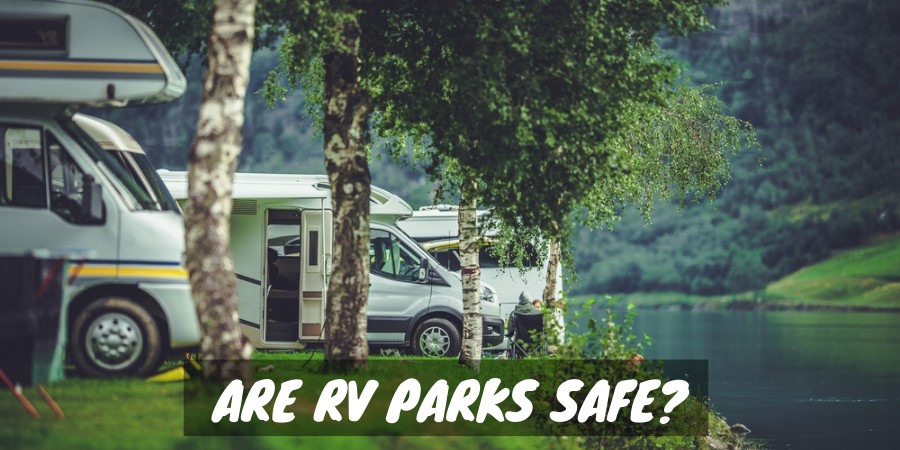Exploring the great outdoors in an RV brings freedom and adventure, but it also comes with its share of maintenance challenges. One such challenge is the battle against mold, a common issue that can sneak up on unsuspecting RV owners.
When an RV sits in storage or has water leaks, it can grow mold. Depending on the situation, it can take a few days or several months for mold to take hold, often hiding behind the walls, floors, and ceiling.
Mold can cause respiratory issues, create musty odors, stain interior surfaces, and rot wood. Learning how to find and kill mold in your RV is critical to protect your investment and to remain healthy when you travel.
This guide will detail all the tips and tricks for finding and eliminating mold in your camper to keep your RV in top condition!
How to Identify Common Molds
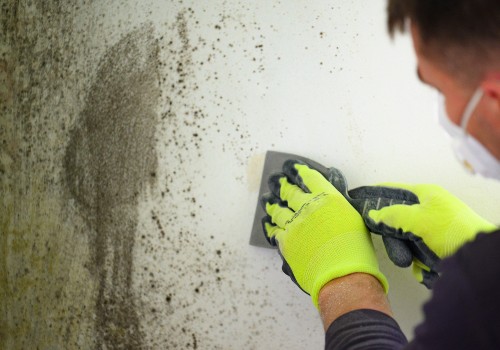
Mold is a genuine concern in closed living spaces, so you must know what signs to look for when cleaning your RV or shopping for a used camper to avoid getting sick on camping trips. Before we get into finding and killing mold in your RV, let’s go over the seven most common molds you may encounter.
Aureobasidium
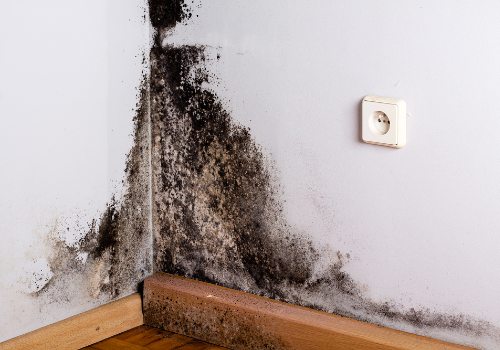
Aureobasidium is a black or pink mold that grows in tile grout, caulk, painted surfaces, and behind wallpaper or RV panels where high moisture levels accumulate. The mold can cause rashes, asthma, hay fever, or inflammatory lung disease.
Alternaria
Alternaria is a common allergenic mold found in homes or RVs that are continually damp. The mold spreads quickly and can cause asthma, lung diseases, and allergies.
The mold has a velvety appearance with dark brown or green hairs and likes to grow inside air conditioners, vents, carpets, window frames, and around leaky sinks, bathtubs, or toilets.
Aspergillus
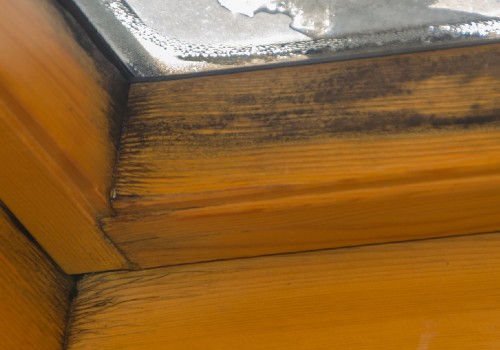
Aspergillus is a toxic mold with over 185 species and can appear in many shades and textures, making it difficult to pinpoint. The mold prefers dark, damp surfaces and causes allergies, nausea, abdominal pain, vomiting, and lung conditions, as well as produces the cancer-causing agent aflatoxin.
Stachybotrys
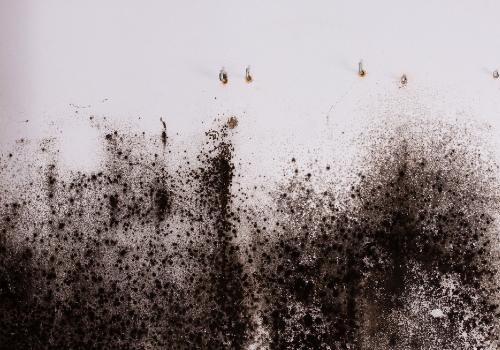
Stachybotrys is another toxic mold that uses the generic term Black Mold even though it can take on a greenish appearance. The mold prefers to grow on wood or paper surfaces after building materials get soaked with water after a leak or flood.
Stachybotrys causes eye and lung irritation, headaches, and general fatigue. Storing your RV in a humid region can also trigger this mold to grow.
Chaetomium
Chaetomium is an allergenic mold that starts with a white cotton-like appearance and changes to grey, brown, and black as it spreads and ages. The mold needs heavy moisture to take hold and can trigger asthma, hay fever, runny eyes and nose, and a scratchy throat.
Studies indicate that Chaetomium promotes cancer formation and causes physical or functional defects in the human fetus, so quick eradication is critical.
Fusarium
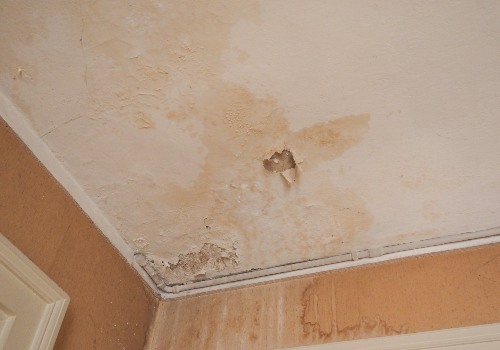
Fusarium lives in the soil and can track into your RV after a hike or gardening. The mold will appear white, pink, or red and causes allergic reactions, followed by severe health conditions if left untreated.
Another concerning factor is that this mold can keep growing during winter storage in cold temperatures when other molds go dormant.
Penicillium
Penicillium mold grows with little moisture and spreads easily through the air. The mold takes on a blue or green shade with a velvet texture and can trigger hay fever or lung irritation in sensitive people.
How to Find Mold in Your RV
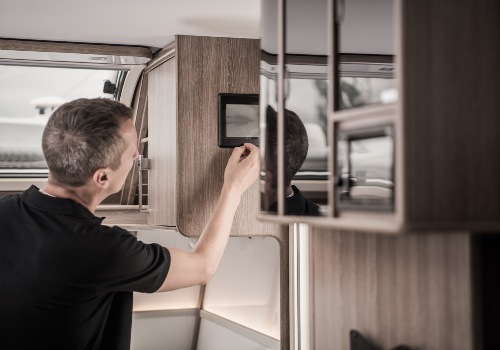
Mold spores float in the air and will find their way into your RV whenever you open a window or door. If spores land in a moist area, mold will grow and spread.
Seeing mold on exposed surfaces is simple, but mold is sneaky and can grow behind the walls, under the floor or ceiling material, or inside cabinets. Some molds are more harmful than others, and many people have mold sensitivity but think they are just dealing with allergies or pollen.
Here are the best ways to find mold in your RV:
Take a Sniff Test
Mold gives off an odor as it grows and digests, which is musty or damp. Other molds emit an earthy or sweet scent noticeable when you first enter the RV or turn on the furnace or air conditioner.
If your camper has an unusual odor that isn’t due to easily recognized causes, such as a new scented candle on the counter or a pile of sweaty hiking clothes, you most likely have a mold issue on your hands.
Look For Visible Signs
Get a flashlight and start looking at all the camper surfaces, including all the interior and exterior cabinets and storage compartments, the awning, and slide toppers. Mold will appear as a fuzzy or flat stain that is white, blue, green, pink, rusty brown, or black.
Areas with mold growth generally lack good air circulation, such as inside the RV shower stall or under the kitchen or bathroom sink. In addition, stains from roof leaks will discolor the ceiling or the top edges of walls.
Sometimes, mold will look like a layer of fine dust over every interior surface, including upholstered furniture. Extensive mold over everything indicates a serious moisture issue and hidden mold growth.
Test the Air with a Toxic Mold Kit
- The information below is per-pack only
- FIND MOLD FAST: MOLD ARMOR Do It Yourself Mold Test kit safely and…
- FOR INDOOR AND OUTDOOR TESTING: The Do It Yourself Mold Test Kit can…
- THREE TESTING METHODS: (1) Indoor Air Quality Test Method (2) Air…
- INCLUDES EVERYTHING YOU NEED: Each air quality tester and mold kit…
You can purchase kits that detect mold in the air, like the Mold Armor FG500 Mold Test Kit.
The kit has a little tray you fill with a solution, and then you check it after 48 hours for signs mold spores are growing. If mold growth is present, you can send the sample off for lab analysis so you know precisely which mold strain is in your RV so you can deal with it properly.
Please be aware that mold spores are everywhere, and not all mold growth is harmful to your health and requires lab testing. If you see slight mold growth after two days, compare it to the various types of mold images you can find online to determine if it’s a standard, slow-growing mold that a good cleaning will eliminate.
Inspect Plumbing Lines, Fixtures, Drains, and Condensation Points
Mold needs water, and a slight leak or even condensation forming on plumbing lines and fixtures will allow it to grow. Water in drain traps can also enable mold to reproduce and spread to other parts of your RV.
Inspect all these areas to check for mold:
- Visible plumbing lines
- Under sink fittings in kitchen and bathroom
- Around the toilet
- Around the outdoor shower connections
- Drain pipes
- Air conditioner ducts/vents
- In and around the freshwater storage tank
- Inside the fridge and freezer
- On window interiors
- ASSESS YOUR HEALTH
Consider the health of guests who use the RV often. Ailments such as headaches, rashes, breathing problems, eye, nose, or throat irritation, or worsening asthma or lung conditions that occur after being inside the camper indicate that mold is present.
Bubbling Wallpaper or Paint
Mold will use cellulose as a food source and love to grow on or behind the thin layer of wallpaper on RV wall panels and painted surfaces. As the mold grows, it loosens the binders holding the wallpaper or paint to the underlying surface and produces bubbly or blotchy areas.
How to Kill Mold in Your RV
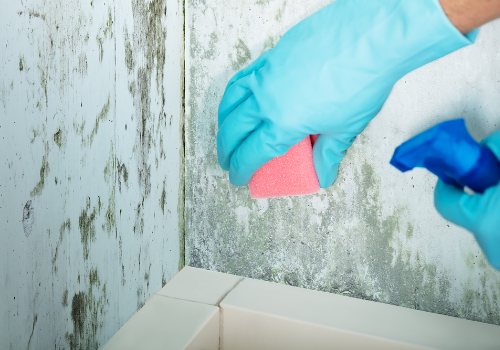
Mold needs quick removal to avoid damage to your health or your recreational vehicle. Leaving mold to spread can cause a total loss of your RV and future camping experiences.
If you plan to clean mold yourself, use caution by wearing a mask, eye protection, gloves, and a long shirt and pants. Ventilate the RV by opening windows and doors so cleaning chemicals do not overpower your senses.
Douse the mold with your cleaner, wipe away surface debris, respray the area, and let air dry. Be prepared to treat the same sections more than once for embedded mold growth.
Here are the best ways to kill mold in your RV:
Use a Commercial Mold and Mildew Remover Spray
- GET RID OF STUBBORN MOLD AND MILDEW STAINS: Our instant spray cleaner…
- USING RMR-86: To safely and conveniently eliminate indoor mold and…
- SAFE TO USE ON MULTIPLE SURFACES: Easily remove stubborn stains from…
- FAST-ACTING SPRAY: Our powerful, fast-acting mold stain remover spray…
- NO SCRUBBING NEEDED: Simply spray our ready-to-use formula on the…
The easiest way to tackle mold growing on the exterior of your camper or the awning is to use a commercial spray made to kill mold and mildew. I like the Rmr-86 Instant Mold and Mildew Stain Remover, but similar products are available online or at home improvement centers.
You can use this spray on areas inside your RV, such as the shower or ceilings, where mold pops up due to excessive moisture without proper ventilation.
Make a DIY Mold Killer Spray
Everyday household products like bleach, vinegar, and hydrogen peroxide can kill mold on interior surfaces.
Pour these formulas into a spray bottle and douse the moldy areas:
- Undiluted white vinegar
- Undiluted 3% hydrogen peroxide
- 1:1 ratio of bleach and water
- 1:1 ratio of ammonia and water
- 2 cups of water and 12-15 drops of tea tree essential oil
- 2 cups of water and 20 drops of grapefruit seed extract
Do not intermix any of these ingredients, especially bleach and ammonia, which will form a deadly gas. Also, use caution when you spray ammonia or bleach, as it can cause fabric, carpet, or wallpaper to discolor.
Want to Connect With a Community of Over 1,078 RV Enthusiasts?
Of all the above mold cleaning options, bleach is the least effective against established mold growth because it can’t soak deeply into porous surfaces where mold roots penetrate. The better alternative is to use an oxygen-based cleaning agent, like hydrogen peroxide or a commercial mold-killing spray.
Hire a Mold Remediation Service
A severe mold infestation may require the skills of mold-removal specialists who have the tools and products to get into your RV’s nooks and crannies.
In many instances, they’ll need to remove and replace damaged ceilings, wall panels, carpeting, upholstery, and curtains to prevent any embedded mold spores from reinfesting your RV.
Killing Mold in an RV or Camper (Video)
Are Mold and Mildew the Same?
Mold and mildew are different types of fungal growth.
Mildew lives on the surface of wallpaper, wood, fabric, and other RV materials and rarely causes issues in healthy people. Mildew appears flat, is white or grey, and is removed quickly with a bleach solution.
Mold is much harder to kill because it has roots that grow into porous surfaces, and spores can lie dormant until the ideal conditions for growth occur. In addition, mold releases spores and harmful mycotoxins into the air, spreading the colony to new areas and causing minor to serious health problems.
How to Keep Mold Out of Your RV
Here are the best ways to keep mold from growing in your RV. Following as many tips as you can help ensure your camper remains mold-free.
Wash and Maintain RV Exterior
Keeping your RV exterior clean and checking for and fixing any roof damage, shrinking, or missing caulk that allows water to leak into your camper is the first step in stopping mold.
Reduce Interior Humidity Levels
- DON’T JUST COVER UP ODORS, ELIMINATE THEM: DampRid 11-ounce Refillable…
- 10% MORE MOISTURE ABSORBING POWER* (*Compared to 10.5oz cup). Watch…
- LONG-LASTING FRESHNESS: Lasts up to 45 days depending on temperature…
- GREAT FOR USE IN closets, bathrooms, laundry rooms, pantries, under…
- DECORATIVE DESIGN: Featuring a decorative design, these moisture…
Humans emit moisture when breathing, so condensation will become an issue if you keep RV doors and windows shut all the time. Adding in running the water for a shower or washing dishes will only compound the problem.
The easy fix is to run vent fans or open windows to air out the RV interior, especially after showering.
The next best option is to run a dehumidifier or air conditioner to remove excess moisture from the air efficiently. Mold has difficulty growing when the relative humidity is below 50 percent, so make sure you program the unit below this level.
Lastly, use desiccant products like Damp-Rid in closets and cabinets during active use and when the RV is in storage.
Use an Air Filter
Running an air purifier with a HEPA air filter can prevent mold spores from landing and growing on RV surfaces.
Clean Surfaces Often with Disinfecting Wipes
Make it a habit to disinfect RV surfaces each evening to kill and remove spores before they have a chance to grow.
Vacuum Carpets
Carpets will grab mold spores off your shoes, so vacuuming often and using a HEPA vacuum filter bag will pull them from the fibers and reduce the chance of spreading.
Fix Leaks Right Away
Leaks in the plumbing system are a top cause of moldy RVs. Fix leaks immediately, and run a fan to dry out damp flooring or walls quickly.
How to Prevent Mold in Your RV (Video)
Final Thoughts
You don’t need to camp with mold when you take precautions to avoid it from growing on or in your RV.
A mold-free camper protects your investment and lets you breathe easier, knowing the air isn’t full of harmful toxins. So please use the tips above to find, kill, and keep mold from hitching a ride on your next RV trip!
"Man cannot discover new oceans unless he has the courage to lose sight of the shore."
-- Andre Gide

